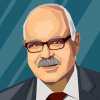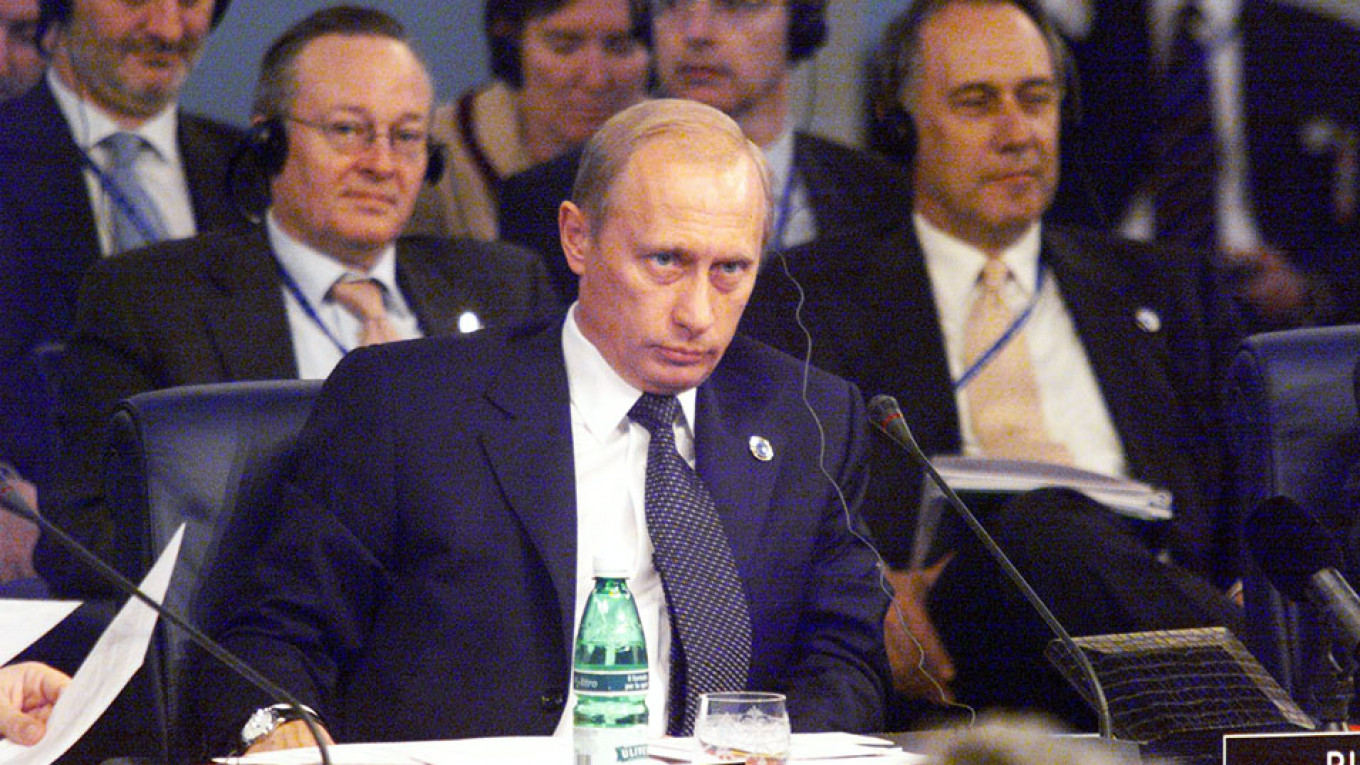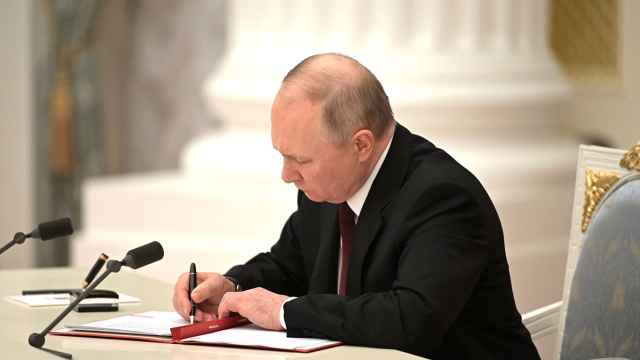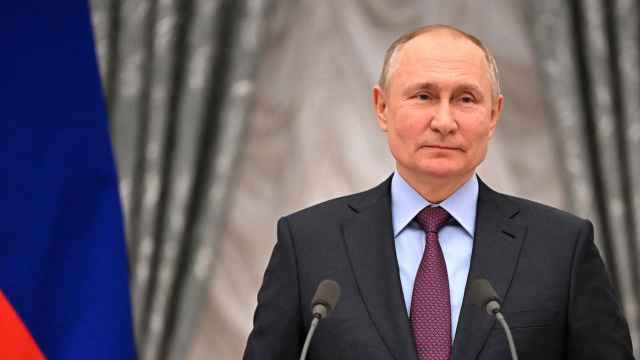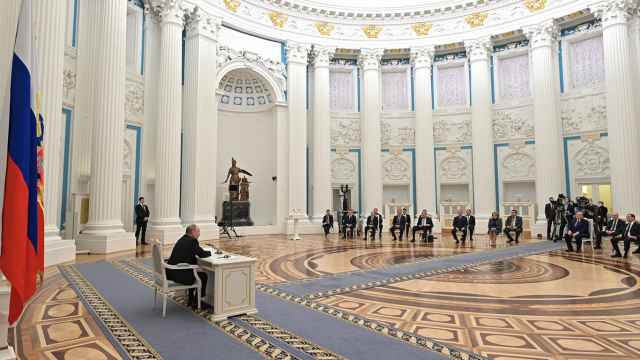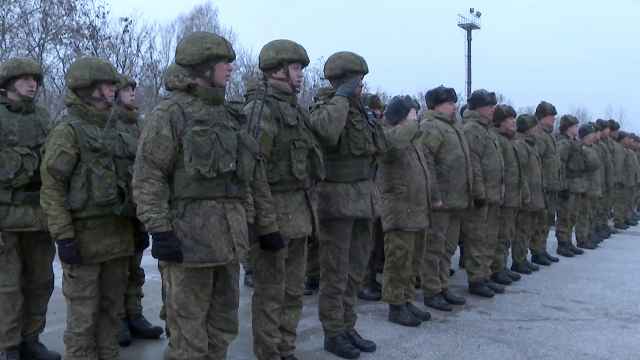Vladimir Putin has been in power for 20 years, but the time has not yet come to pass final judgment on his rule, including in the foreign policy sphere. The situation is dynamic, and the future, as always, unpredictable, but at the time of writing Putin has almost five years left of his current mandate — and it appears he will continue to be an influential political figure in Russia for a period beyond this term.
Nonetheless, it is clear that the Putinist era is drawing to a close and an attempt to make sense of what has (and has not) been achieved over the last 20 years is not only useful, but necessary in view of the inevitable changes that await Russia in the future.
The results of Russia’s foreign policy during the Putin era can be evaluated on various grounds and criteria. Since 1999, as far as I can see, the president has pursued two main goals: To preserve the unity of Russia and to restore its status as a great power in the global arena. He has achieved this.
The supremacy of central power has been affirmed across the Russian Federation. And Russia itself, which at the turn of the 21st century had almost been written off as a global power, returned to the global arena one and a half decades later as one of the biggest and most active geopolitical and military players.
From the point of view of these twin goals, these are unquestionable achievements, though the centralization of power and great-power status have not come cheap.
The power vertical has been constructed on the authoritarian basis that is traditional for Russia. The political regime that replaced the chaos of the 1990s has been unable to mature into a full-fledged state: it predominantly services the needs of a narrow elite, exploiting the country’s resources for their personal and collective aims.
Given the gradual but palpable growth of civil consciousness among Russians, this is likely to cause serious problems in the future. We also need to take into account that Russia’s confirmation as a great power has taken place in the context of a renewed confrontation with the U.S., which signals a long and uneven struggle.
Vladimir Putin’s foreign-policy legacy is sweeping and varied: A complex and contradictory process that has changed on more than one occasion over the course of its formation.
Back in 2000 Putin was actively calling for Russian membership in NATO; in 2001, attempting to become the United States’ most important ally, he gave orders to provide any assistance and support to American troops in Afghanistan; building a Greater Europe that would stretch from Lisbon to Vladivostok, Putin not only gave a speech in the Bundestag in German in which he proclaimed Russia’s European choice, but emphatically encouraged the exchange of capital for the creation of a common economic space.
Putin’s legacy will be carefully studied and analyzed in the years to come. So today it makes sense to examine it in practical regard, through the prism of certain questions: What is of abiding importance and should be preserved for the next generation of Russian leaders? What needs to be changed and developed? What should be best avoided in the future?
Successes
First, let’s look at the successes. It is undeniable that under Putin Russia restored real sovereignty. The rapid growth of oil prices in the 2000s allowed the country to make the transition to economic growth on the new capitalist foundation created in the 1990s and free itself from external financial dependence.
The nationalization of a significant part of Russia’s oil industry in the mid-2000s created a basis for a coordinated energy policy. The reforms of the armed forces carried out in the first half of the 2010s gave the Kremlin an effective instrument for the defense and promotion of the country’s interests. Stable support for Putin from the majority of the population ensured the system’s stability, while the power vertical provided a mechanism for the president to exert his political will.
It is equally clear that at the outset of the 21st century Russia effectively reclaimed for itself the status of a great power. We need to understand here that a great power is essentially a military-political concept. In a contemporary context, this is a state that is resistant to external pressure and capable of forging an independent political course, and — when necessary — defending itself without outside help. Russia’s attempts in the 1990s and 2000s to secure an autonomous status within the Euro-Atlantic system ended in failure.
The Russian elite and society, in general, did not recognize the leadership of the U.S.: An essential condition for integrating into the Western system.
Russia was also unable to build its own power center in Eurasia, mainly due to the disinclination of the elites of the former Soviet republics to recognize Moscow’s leadership.
For Russia, a country that was both independent and isolated, this meant that great-power status was essential.
This double failure forced Putin into a sharp turn in the second half of the 2010s. From the outside, this looked like a turn from a Greater Europe toward a Greater Eurasia, which many took for a pivot to the East, specifically to China.
In fact, this was a pivot by Russia toward itself, in search of a balancing point in a quickly changing global environment. Russia’s current self-determination is an affirmation of itself as a major independent power in the north of the Eurasian continent, directly bordering East and Central Asia, Europe, the Middle East, and North America. Moscow is no longer oriented toward any one side in particular — to Europe, the U.S. or China.
It is now interacting with all those in its vast neighborhood and is being guided in this by its own interests alone.
Even before Russia’s confrontation with the U.S. and the falling-out with the EU, the eastern course of foreign policy under Putin acquired for the first time a significance and status that brought it level with the traditionally predominant eastern vector.
This has brought a balance to Russian foreign policy, though for the time being it is unstable.
On one hand, heightened interest in the East was a consequence of the rise of Asia as the global center of the world economy and politics. On the other hand, Moscow was obliged to acknowledge the weakness and vulnerability of its geopolitical and geoeconomic position in the east of the country. With this in mind, in the 2000s Putin put a great deal of effort into reaching a final resolution on border issues with China and the cultivation of a close and productive partnership with Beijing.
The Putin era has seen the beginnings of what we might provisionally call Russia’s Asian policy. Alongside China, Putin aimed to develop relations with India as a great Asian power comparable with China and a traditional strategic partner for Moscow; with Japan and South Korea as resources for the import of technology and investments; with the ASEAN countries as a large and growing market. Post-Soviet economic integration, which was launched in 2009 as part of the Eurasian Economic Union (EAEU), acquired a Central Asian accent.
Bilateral relations and multilateral formats — in particular, as part of the Shanghai Cooperation Organization, BRICS and RIC (Russia, India, China) — have created conditions in which Russia, neither the largest nor a dominant player, has so far been able to maintain balance with more powerful or advanced countries and stand up for its interests more or less effectively.
The new quality of Russian foreign policy — its dynamic balance — was demonstrated most vividly in the Middle East, especially with the start of military operations in Syria in 2015. Here Moscow occupied a unique position as a player that was capable of maintaining productive contacts with all the significant forces in the region, including the most stubborn antagonists such as Iran and Israel.
By deploying its armed forces in Syria in relatively modest volumes, at relatively low cost and with limited losses, Russia achieved its direct aims. Furthermore, Moscow was accepted in the region as a serious player for the first time since the collapse of the U.S.S.R. The secrets of this success lie in the fact that here Russian actions are clearly focused on its interests (and not on its own ideology; in its refusal to impose some geopolitical model on other countries; in a good knowledge of the region and the capability and readiness to pursue a policy based on local realities.
Syria and the Middle East, in general, were a signal that Russia was returning to the global arena and was becoming a global player — but a rather different player from the U.S.S.R. Instead of expending enormous efforts on trying to export its model to the rest of the world, Moscow is now trying to find niches that it can exploit to its own benefit.
Apart from the export of energy resources, arms, nuclear technology, and foodstuffs, Russia is acting as a military and diplomatic player that provides political cover for a number of states, offering its services as a guarantee of security. In this guise it is active beyond Europe and Asia: Russia’s profile has risen in the Middle East, as well as in Africa and Latin America.
The main challenge here is not to incur a strategic defeat while chasing tactical gains.
Resolving this problem requires coordinated action in various spheres and at various levels. Moreover, in order to reinforce the respect of others, Russia must be true to its principles and values
The final opportunity that has appeared under Putin is the Arctic, which — as a result of climate change — has turned into a new arena for the development of relations with the outside world and a new front for confrontation with its rivals.
Failures
A number of Putin’s initiatives have not been seen through to the end. Putin proved unable to carry out the nationalization of the elite that he had promised. More importantly, he has been unable to form a ruling elite that truly cares about national interests.
The cohort he brought to power has largely turned out to be too susceptible to material temptations. Even today the Russian elite remains essentially a group of individuals who have not only placed their corporate interests above those of the nation and the state, but who live in isolation from their country, and practically at its expense. This exemption from the strict moral restrictions and duties of state service is what sets the current elite completely apart from their Soviet and imperial predecessors. This flaw in the existing political order deprives it of long-term prospects.
The switch from plans for building a Greater Europe to the idea of a Greater Eurasia was painful.
Cooperation with Europe — Russia’s closest neighbor — has stalled not only as a result of the Ukrainian crisis and fundamental disagreements on political and social values.
The fundamental error of Russian foreign policy since the mid-1990s has been the fixation on the problem of NATO expansion.
The basis of this cooperation was the European idea of bringing Russia into ever-closer alignment with European norms and principles, but without EU membership, and the Russian hope that with the end of the Cold War the elites of the EU countries would leave their Atlantic orbit and begin to build a Greater Europe together with Russia.
However, this turned out to be unsustainable. Although it is essential to maintain political contact with all the major powers, the attempts in the prevailing conditions to play at politics in EU countries, assisting nationalist political forces and throwing down a challenge to the ruling elites, was a mistake.
For the foreseeable future, interaction between Russia and Europe will be largely based on economic, scientific, cultural and humanitarian ties. Geopolitics and defense will remain the lot of Russia-U.S. relations.
Russia has not yet been able to reboot its partnership with India. The stagnation of relations between Moscow and Delhi, which began with the collapse of the U.S.S.R., goes on.
The level of Russian cooperation with India, whose economic might and international ambitions are growing rapidly, is falling further and further behind the level of interaction with China. In combination with the significant weakening of relations with the EU, this creates a threat to Russia’s geopolitical equilibrium in Greater Eurasia.
The situation is only being compounded by the feeling that talks on the signing of a peace treaty between Russia and Japan are approaching a dead end.
Putin has put a lot of effort into turning Japan into a resource for the Russian economy and technological modernization, as well as an element in the Greater Eurasian system of balances. The failure of this Japanese project may further increase Russia’s dependence on China. In this respect, forging closer ties with India and Japan is becoming essential in order to avoid such a scenario.
Economic integration with several CIS countries, which Putin launched with the creation of the Customs Union, clearly serves the interests of Russia and its partners. At the same time, the EAEU is a project with important but limited aims. There are no prospects for it to transform into a full-fledged — economic, geopolitical, military — power center in Eurasia.
Russia’s partner members, including the closest — Belarus and Kazakhstan — are extremely anxious when it comes to the preservation of their sovereignty. Independence for Minsk and Nur-Sultan is above all independence from Moscow. There is also no possibility of the EAEU becoming a serious competitor or full partner to other international unions — the EU, the ASEAN, or China. Further integration — including with Belarus — must not fail to take these realities into account.
Mistakes
Finally, a number of Putin's ambitions have not stood the test of time.
Russia of course should welcome the idea of a multipolar world, i.e. a world of geopolitical and geoeconomic equilibrium as it corresponds to the interests of the country.
At the same time, Putin’s obsession with the idea of changing the existing global order, i.e. making active efforts to eliminate the global hegemony of the U.S., is harmful.
Supporting Washington’s enemies solely because they oppose the global hegemon does not reinforce your own position: It creates additional problems. What is important for Russia is not the global order in itself, but Russia’s place in this global order.
Carving out a worthy and beneficial place in the new global order that is forming requires the setting of clear goals and a well-thought-out strategy.
The absence of a long-term strategy and the gusto for cunning opportunism and tactical maneuvering condemns foreign policy to substantial risks.
Putin has stated several times that Russia will not permit a confrontation with the U.S., but in fact the two countries have been locked in a confrontation for five years already.
We are now hearing similar promises that there will be no new arms race with the U.S., but amid the dismantling of the arms control system — a process initiated by Washington — there are no guarantees that it will be possible to maintain the military-technical balance with the U.S. without a serious increase in defense spending.
Of course, far from everything depends on Moscow; Washington has its plans and strategies, which can change — including in ways that will be unpalatable for Russia.
That’s not the point. Since it does not have the financial clout of the U.S., Russia is obliged, while protecting its interests, to avoid frontal confrontations with its rival.
The fundamental error of Russian foreign policy since the mid-1990s has been the fixation on the problem of NATO expansion.
There is no doubt that the accession of the U.S.S.R.’s former allies in Eastern Europe and the Baltic states to NATO has done nothing to bolster Russia’s security and has weakened Moscow’s strategic position. At the same time, the information war Moscow has been waging in relation to NATO expansion, and the attempts to politically counter the alliance’s advance to the east, have not only failed to reduce the negative consequences for Russia, but deepened them.
And the military and political moves Moscow made in the course of the Ukrainian crisis breathed new life into NATO and helped to resurrect the image of Russia as the military adversary of the West. The rebirth of this image a quarter of a century after the end of the Cold War is a strategic defeat for Russia.
The roots of this mistake can be found in an outdated mode of strategic thinking that assigns excessive importance to the factor of geography and strategic depth. The terrible trauma of June 22, 1941 demands that the forces of a potential enemy be kept as far away as possible from the country’s most important political and economic centers. It was according to precisely this logic that the U.S.S.R. created a buffer zone for itself in Eastern Europe after World War II.
But the appearance of nuclear arms and strategic aviation as early as the second half of the 1940s, followed soon after by intercontinental ballistic missiles and submarine missile carriers, practically stripped this strategic buffer of any significance.
In today’s circumstances it is difficult to imagine the creation of a bridgehead along Russia’s borders for launching a mass assault on it, as in 1941. The military potential that presents a genuine threat to Russia is concentrated in a completely different place, mainly in the United States. Accordingly, the responses to these threats must be directed at their original source. It is in this that the basis for strategic stability lies.
There is also another side to this issue. If for Russia the problem is not NATO as an alliance of almost 30 states of various capabilities, but NATO as a platform for the deployment of American armed forces and hardware targeted at Russia, then whether this or that European country is a NATO member does not solve Russia’s security problem. The fact is that nothing prevents Washington from sitting its bases and weapons systems on the territory of U.S.-oriented countries that are not NATO members.
So, while post-2014 the U.S. Navy has lost access to Sevastopol, it is establishing a foothold in Ochakov and Odessa. The appearance of new American bases on the territory of U.S.-friendly countries in Eastern Europe depends almost entirely on decisions taken in the White House.
The exaggerated importance accorded to NATO expansion has had a decisive influence on Russia’s policy toward Ukraine. And it is Moscow’s Ukrainian policy that has produced the most serious mistakes of the last few years.
This does not concern Russia’s actions in Crimea, which were a reaction to the sharp changes in the situation in Kiev, but is primarily about the logic of Russia’s behavior prior to the Ukrainian crisis of 2014, which was a watershed moment in the whole history of Russian foreign policy in the post-Soviet period.
Apart from the unjustified fear of an advancing NATO, the cause of the mistakes was rooted in the Kremlin’s inaccurate view of the aspirations of Ukrainian elites and of the character of Ukrainian society. Moscow believed that the Ukrainian elites could be co-opted into the Eurasian integration project and the Ukrainians and Russians — two branches of a single people — would support this. There was a prevalent view that without Ukraine it would be impossible to achieve critical mass for the creation of a Eurasian center of power 200 million people strong.
Putin's attempt to include Ukraine in the EAEU was not merely in vain. This integration, had it been possible to realize, would from the outset have been extremely problematic and costly for Russia and would ultimately have failed: The Ukrainian elite’s “independent” political project, which it has no intention of abandoning, is fundamentally incompatible with any form of integration with Russia, even purely economic.
It appears the Kremlin had mistakenly calculated that Viktor Yanukovich’s instinct for self-preservation would kick in at the last moment and he would drive the protesters off the Maidan.
But this would have ended in an even larger crisis in relations with the U.S. and the EU for Moscow, with even more severe consequences than those that it has incurred as a result of Crimea and the Donbass. Russia needs to acknowledge that in Ukraine it now has a large and hostile neighbor, and this will be the case for a long time to come. The only consolation for Moscow is that Ukraine’s internal problems have ceased to be a burden for Russia. Also, it appears, for a long time, and probably forever.
The Putin era, however, goes on, and it is still too early to make a final judgment.
The Russian language version of this article was originally published by Vedomosti as part of the series that considers the social, political and economic transformation of Russia over the last 20 years under Putin's rule. Read also:
20 Years of Vladimir Putin: How Russian Society Has Changed
20 Years of Vladimir Putin: The Transformation of the Economy
20 Years of Vladimir Putin: The Rise and Decline of a Regime
A Message from The Moscow Times:
Dear readers,
We are facing unprecedented challenges. Russia's Prosecutor General's Office has designated The Moscow Times as an "undesirable" organization, criminalizing our work and putting our staff at risk of prosecution. This follows our earlier unjust labeling as a "foreign agent."
These actions are direct attempts to silence independent journalism in Russia. The authorities claim our work "discredits the decisions of the Russian leadership." We see things differently: we strive to provide accurate, unbiased reporting on Russia.
We, the journalists of The Moscow Times, refuse to be silenced. But to continue our work, we need your help.
Your support, no matter how small, makes a world of difference. If you can, please support us monthly starting from just $2. It's quick to set up, and every contribution makes a significant impact.
By supporting The Moscow Times, you're defending open, independent journalism in the face of repression. Thank you for standing with us.
Remind me later.

